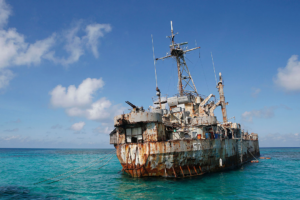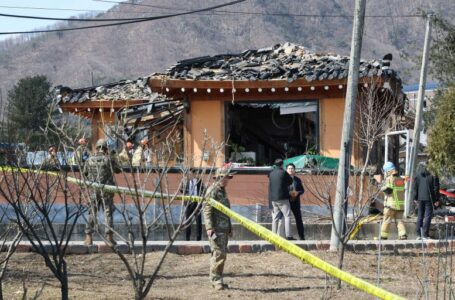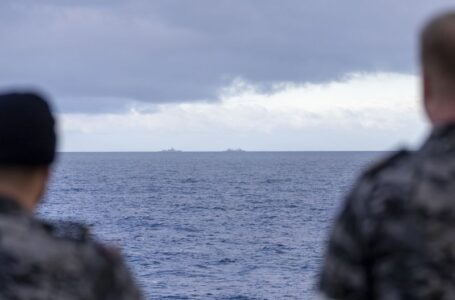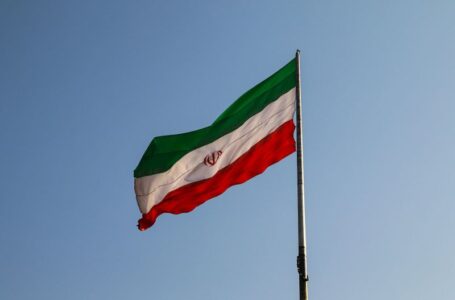South Korean fighter jets accidentally bomb homes, injuring 15 civilians
Philippines moving boldly into infrastructural power play


By Kyle Aristophere T. Atienza and John Victor D. Ordoñez, Reporters
IT HAD been, for a time, a mission aborted for a coalition of civic groups that sought to deliver food and other supplies to Filipino fishermen and other civilians in Philippine-occupied features in the South China Sea.
Its 40-boat convoy was forced to change course on the night of Dec. 10 after leaders said they had been shadowed by Chinese vessels on their way to Lawak Island, which China calls Nanshan, in the disputed Spratly Islands.
But to the surprise of many on board as well as journalists awaiting updates in Manila, a smaller boat had veered away from the direction of the lead supply ship, which was bound to return to the province of Palawan with the rest of the small boats, and managed to slip past the gigantic vessels of China which, in recent months, has been blocking the resupply missions of the Philippine government.
The Dec. 10 incident involving Filipino civilians and Chinese state forces, which followed two separate water cannon attacks of the Chinese coast guard against Philippine government vessels, is just a microcosm of both the challenges and opportunities facing Manila’s bid to modernize its infrastructure and build new ones within its 200-nautical mile exclusive economic zone (EEZ) in the South China Sea, according to experts.
THE INFRASTRUCTURE RACE“There is a brewing race among claimants to build infrastructure in their occupied features to consolidate control and beef up their claim for effective jurisdiction,” Lucio B. Pitlo III, a research fellow at the Asia-Pacific Pathways to Progress Foundation, told BusinessWorld in a Messenger chat.
Mr. Pitlo said the Philippines should consider building more wharves and ports to house ferries and coast guard vessels in the Kalayaan Island Group to improve logistics and response times during emergencies.
“Manila should not be left out in this infrastructure build-up in the flashpoint,” he said, pointing out that not only China is moving into the many maritime features in the South China Sea.
For the Philippines, the main barrier to pursuing massive infrastructure development in the West Philippine Sea is China’s interference as demonstrated by its ongoing illegal blockade of Second Thomas Shoal, said Raymond M. Powell, a fellow at Stanford University’s Gordian Knot Center for National Security Innovation.
He noted that China restricts the delivery of anything but food and replacement troops to BRP Sierra Madre, a World War II-era vessel that the Philippines intentionally grounded in the shoal in 1999 to serve as an outpost for Filipino troops
This action was aimed at asserting the Philippines’ sovereignty after China seized Mischief Reef.
“Right now Beijing is especially focused on Ayungin Shoal (Second Thomas Shoal), where its long-time strategy has been to blockade the BRP Sierra Madre until it disintegrates,” said Mr. Powell. “So, any efforts to build there will certainly draw a reaction.”
BRP SIERRA MADRE, a marooned transport ship which Philippine Marines live in as a military outpost, sits on the disputed Second Thomas Shoal, part of the Spratly Islands in the South China Sea. — REUTERS
“Should China decide to widen the blockade to include other Philippine-held features, that would be an escalation of its aggression, though it’s not clear that would happen,” he said in an e-mail. “After all, Vietnam is currently building out many of its own outposts without direct interference by Beijing.”
Vietnam has been expanding its reclaimed area in the Spratly Islands through dredging and landfill work, which started in 2021 and measures about 750 acres as of November this year, according to the Asia Maritime Transparency Initiative.
From 2013 to 2016, China has created about 3,200 acres of land in the South China Sea.
The Philippine Department of Foreign Affairs (DFA) has urged China to stop what it called the “militarization of the South China Sea.”
In August, Armed Forces of the Philippines (AFP) Chief General Romeo S. Brawner, Jr. vowed to boost the country’s military presence in the South China Sea, given China’s aggression and the Philippines’ having only a few small structures occupied by state military and naval forces in the waterway.
Mr. Pitlo said the government should also consider building more naval vessels to patrol the marine features in the waterway. “The state should also work with the private sector and international shipbuilding firms to boost the country’s shipbuilding capabilities,” he said.
The geopolitics expert said the state should harness the Agila Subic Shipyard in Zambales to build more capable marine vessels to sail the disputed waterway.
POWER OF THE PURSEVictor Andres C. Manhit, president of think tank Stratbase ADR Institute, said the restoration of the BRP Sierra Madre should be among the top priorities of the government because once it becomes uninhabitable for troops stationed there, “the Philippines will lose its presence in the shoal.”
The restoration of BRP Sierra Madre was among the highlights of the proposed P5.768-trillion 2024 national budget ratified by Congress on Dec. 11, months after the House of Representatives stripped several non-security departments of their confidential and intelligence funds to bolster the Philippines’ presence in the South China Sea.
The House move resulted in a total amount of P1.23 billion saved, with the Department of Transportation (DoTr) receiving an additional P381.8 for the development and expansion of an airport in Thitu Island, which the Philippines calls Pag-asa.
Speaker Ferdinand G. Martin G. Romualdez said Congress would allot P3 billion to develop islands in the South China Sea, which includes a 500-meters extension of the Pag-Asa Island runway to accommodate larger aircraft. This would also widen the opposite area to serve as shelter for fishing vessels during bad weather, said the Speaker.
Similarly, Senator Francis “Chiz” G. Escudero earlier proposed to build a pier and lodging structure for Filipino soldiers and fishermen at Second Thomas Shoal, which the Philippines calls Ayungin Shoal.
Lawmakers also allocated an additional P300 million for the National Intelligence Coordinating Agency and an additional P100 million for the National Intelligence Coordinating Agency, while the Philippine Coast Guard (PCG) got an additional P200 million for its intelligence activities and ammunition.
After the bicameral conference, Senate President Juan Miguel F. Zubiri said he had pushed the addition of P10.47 billion to upgrade the Philippines’ defense capabilities and enhance presence in the South China Sea. Of the total amount, P6.17 billion was added to the budget of the Defense department for the Philippine Navy, P2.8 billion for the Philippine Coast Guard, P1 billion for NICA, and P500 million for the Department of Environment and Natural Resources for the proposed establishment of a Marine Research Center in one of the Philippine islands in the waterway.
On Dec. 20, Philippine President Ferdinand R. Marcos, Jr. signed the General Appropriations Act (GAA) of 2024 into law.
Also recently, the Senate passed a bill seeking to boost the country’s defense program through investments in local defense equipment manufacturing amid rising tensions with China. The program will get P1 billion in seed funding.
Lawmakers have also proposed legislation establishing Philippine maritime zones and territories extending to disputed areas in the South China Sea.
Senator Francis N. Tolentino had said that the Senate Special Committee on Maritime and Admiralty Zones would craft a Philippine map to assert the country’s claim in the disputed waterway.
“Clearly the government needs to increase the capacity and capability of its maritime forces in order to present a credible deterrent to People’s Republic of China’s aggression,” Mr. Powell said. “In that sense, commitments from the legislature to increase budgets and from international partners to assist are welcome developments.”
BEACON OF STRATEGIC IMPORTANCEMr. Powell said the PCG station on Pag-Asa Island that was inaugurated in early December is an “excellent example” of the kind of infrastructure that will help the Philippines fully establish its presence in the South China Sea.
The Philippine Coast Guard inaugurates its three-story Kalayaan station on Pag-Asa Island on Dec. 1, 2023. — PHILIPPINE COAST GUARD FACEBOOK PAGE
“The Philippines should make its surveillance and monitoring of China’s ships there public on a continuous basis,” he said, adding that if China wants to keep stationing its coast guard and militia ships so close to Thitu Island, “let them be subject to international scrutiny.”
Among all Philippine-occupied features in the Spratly islands, or the Kalayaan Island Group, Pag-Asa is the only one inhabited by Filipino civilians and has the most number of facilities and structures. The Philippine government formally established the municipality of Kalayaan on the 37.2-hectare island in 1978, through a presidential decree of Mr. Marcos’ late father.
China has been claiming ownership over Pag-Asa, calling out the Philippines for “illegally occupying” it.
“In the vast expanse of the West Philippine Sea, Pagasa Island stands as a beacon of strategic importance and potential prosperity,” said Joshua Bernard B. Espeña, a fellow at the International Development and Security Cooperation. He noted that the island is key to fostering “inter-island trade and tourism” within the Philippine EEZ.
At present, the island has a landing ramp, a dual use military and civilian airstrip, a lighthouse, a lying-in clinic, a communication tower powered by Smart, and a small school for basic education.
It is also home to the only marine research center of the Philippines in the South China Sea, which the government wants to upgrade with a mini-museum.
The government should also develop a multifunctional Western Command outpost on Pagasa Island, which would serve as both a military stronghold and an evacuation facility during national calamities, Mr. Espeña said.
“It should boast state-of-the-art command-and-control facilities, a protected cyber network, and coastal defense systems,” he added. “Operational security is a paramount concern, considering potential cyber-electronic warfare attacks or espionage.”
The vision for Pag-Asa Island as a logistic hub for the military and the coast guard and as a thriving fishing community should also be applied to other Philippine-occupied islands in the Spratlys, such as Likas Island, Parola Island, Lawak Island, Kota Island, Panata Island, and Patag Island, said Mr. Espeña.
These islands should have command-and-control facilities equipped with radar and jammers, coastal air defense and anti-ship missile batteries, as well as berthing and docking areas for ship replenishment, crew rest, and maintenance.
They should also cater to the replenishment needs of Filipino fishermen, Mr. Espeña said, citing previous plans to establish an express fisher’s hub on each island.
CIVILIAN LIFEAbove all, Mr. Manhit said Philippine features in the South China Sea should contribute to the national economy and cater to the needs of Filipino civilians, including fishermen.
“We see this in the efforts of the local government in organizing tourist activities such as The Great Kalayaan Expedition, the marine science research activities, and the regular ferry service for Kalayaan residents,” he said.
A modernized West Philippine Sea should make life on Pag-Asa Island “more comfortable for the residents,” he said, noting that a robust internet connection is also needed by the residents. “There should be enough teachers, and hospital workers as well as facilities for basic welfare services,” said Mr. Manhit. “A modernized West Philippine Sea should also include robust economic activities, which include fishing and other livelihood activities.”
Aside from Pag-Asa Island, other features held by the Philippines should also be sites for regular tourism activities and marine science research activities, he said.
The Pag-Asa research station of the University of the Philippines Marine Science Institute. — UP-MSI WEBSITE
“Eco-tourism represents yet another innovative way to raise the international profile of this issue outside of the security realm and make it harder for Beijing to hide its aggression,” Mr. Powell said.
A sooty tern protecting its egg on Lawak Island in Kalayaan Municipality. — PALAWAN COUNCIL SUSTAINABLE DEVELOPMENT
On the economic front, there are pending bills in Congress seeking to designate some Philippine features in the South China Sea, including the Pag-asa Island, as an ecotourism destination and protected area. Earlier this year, Speaker Martin G. Romualdez said the Kalayaan town could be a key tourist destination comparable to the Maldives.
The municipal government of Kalayaan has been offering week-long tours, including the Pag-Asa Summer Tour (in May 2024 and May 2025), which allows travelers to stay in the main island and participate in its festival, and The Great Kalayaan Expedition, where tourists take part in various activities such as diving, bird watching, and fishing, among others, with tours slated for March, April, and May of 2024 and 2025.
Twenty tourists boarded a yacht at Ulungan Bay, Palawan for a seven-day trip to the islands of Lawak, Likas, and Pag-Asa in June, 2023. — PHOTO C&E PHOTOGRAPHY AS SHARED BY THE MUNICIPAL GOVERNMENT OF KALAYAAN ON FACEBOOK
PUBLIC-PRIVATE COOPERATIONThere are also calls for the government to allow gas and oil exploration activities in the waterway, as the Philippines faces an energy crisis that could heavily impact the national economy.
Experts said pushing for a modernization agenda within the Philippine EEZ requires cooperation between the national government and the private sector at the national level.
“Encouraging private sector investment in strategic areas identified by the government is essential. This involves not only providing materials for development, traded goods, and essential services but also addressing critical military logistics to ensure effective sea control,” Mr. Espeña said.
As the maritime security domain expands to include cyber warfare, the private sector may offer its expertise on emerging technologies to detect, mitigate, and respond to cyber threats, Mr. Manhit said. “Tapping the private sector’s expertise and resources will enable the Philippines to boost its technological capacity to address the myriad of security threats in the West Philippine Sea,” he told BusinessWorld in an email.
Don McLain Gill, who teaches international relations at De La Salle University, said China’s “expansionist behavior” in the disputed waters may make it difficult to convince potential investors to pursue infrastructure projects.
“China may create both physical and economic obstacles for companies to effectively carry out their projects in the West Philippine Sea largely due to logistical challenges,” he said in a Facebook Messenger chat.
“Therefore, motivating the private sector to play an active role in shaping our interests in the West Philippine Sea is crucial, and it will be equally important to create the basic conditions for maximizing such projects,” Mr. Gill added.
Gregory B. Poling, director of the Asia Maritime Transparency Initiative at the US-based Center for Strategic and International Studies, said legal hurdles may prevent foreign companies from actively participating in the Philippines’ modernization agenda for the South China Sea.
“The private sector could also play a key role here, though it will likely be Filipino rather than foreign companies that do most investments due to both legal hurdles and potential business risks,” he said.
“No foreign governments take a position on sovereignty over disputed islands like Pag-asa, though they do recognize Philippine rights to its own waters, including at Second Thomas Shoal,” Mr. Poling said in an e-mail.
Meanwhile, Mr. Powell believes Manila should recognize that many of its foreign partners will be hesitant to openly side with the Philippines regarding specific island claims.
“China is not the only country with overlapping South China Sea claims,” he said, citing Vietnam and Taiwan, which both lay claim to many Philippine-held features.
But even so, a joint Philippines-U.S. military civic action mission to Thitu Island is necessary “to demonstrate US commitment to its ally,” said Mr. Powell.
Mr. Espeña said the Philippine government needs to clearly communicate its defense needs to foreign partners. “These may include specifics such as munitions for air defense, coastal anti-ship missile systems, the development of hangars, sophisticated command-and-control infrastructure, and patrol rafts, among others,” he said.
China is expected to consistently exert influence and pose a significant challenge to any efforts by the Philippines to modernize its assets and assert its claims, said Mr. Espeña.
“Specifically, China is anticipated to escalate its divide-and-conquer disinformation tactics in the Philippines,” he said. “This will likely be accompanied by economic promises to create confusion and disrupt momentum.”
Chinese ships would likely intensify their operations against Philippine vessels, “intending to wear down Filipinos both materially and psychologically,” he added.
But Mr. Manhit upheld that the Philippines is on the right side of history, citing a 2016 arbitral ruling that invalidated China’s expansive claims.
“We have the support of the international community as well as a legal basis for our presence and actions,” he said.











